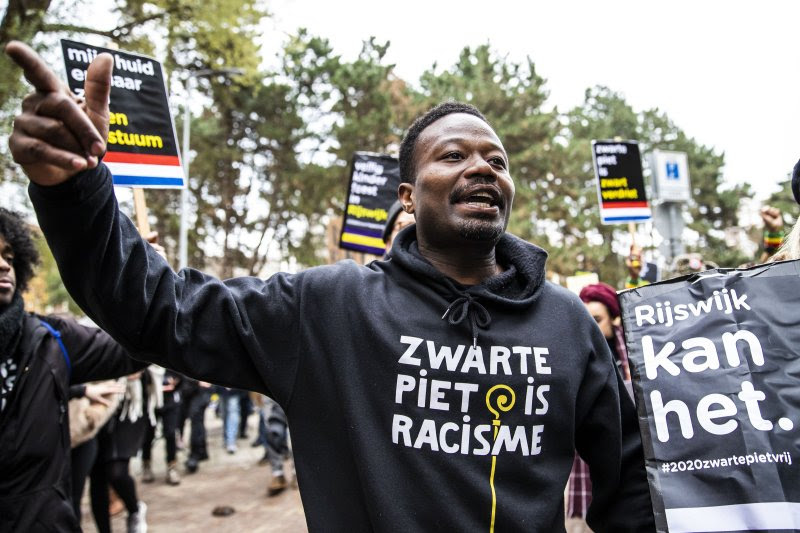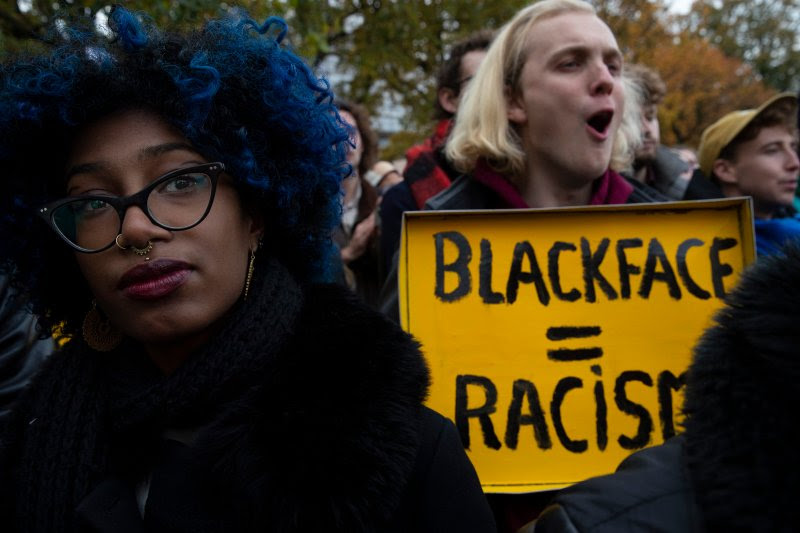By: Charlotte McDonald-Gibson / Amsterdam —
When it comes to places in the world to raise happy and fulfilled children, one country constantly tops the rankings. Almost every year, a new book, article, or report touts The Netherlands as a child-rearing utopia, with the U.N. in September rating the country the best in the industrialized world for kids’ well-being.
But it is also a place where one of the pure joys of childhood—Christmas—is tainted for many kids across the country. As the nights draw in, The Netherlands prepares for the arrival of Sinterklaas, a Dutch amalgamation of St Nicholas and Santa. Accompanying him are his helpers, the Zwarte Pieten or Black Petes, traditionally portrayed by white people as buffoons in full blackface complete with oversized lips and Afro wigs.
Collecting candy from the Black Petes is a rite of Dutch childhood, but one from which many Black children feel excluded. “I do not enjoy it very much,” says Yano, 9, wriggling in the protective embrace of his mom. “It reminds me too much of slavery and my dad is Black, so I know the history of slavery, and that makes me very sad around those holidays when Zwarte Piet is there.”
Yano’s mom—who declined to give her name because of the potential repercussions of speaking out against this hallowed Dutch tradition—tries to shield Yano from the racist caricature. Whenever she hears the jokey music which accompanies the Black Petes, she steers Yano in another direction. Since he was small, she has kept him out of school on the day the Black Petes visit in early December.
But this year, for the first time, Yano will be attending his classes on Dec. 5. After more than a decade of work by local anti-racism activists, and a summer during which the Black Lives Matter movement in the U.S. reverberated around the world, the Netherlands is finally rethinking its dedication to Black Pete. Along with many other school boards, cities and municipalities, Yano’s school has agreed not to feature the figure in their celebrations. His mother, who had long lobbied for its removal, says the killing of George Floyd in the U.S. and its aftermath made the need for change undeniable. “One man had to die and the whole world was protesting, and I think the school opened their eyes a little bit,” she says.
The fight over Black Pete has exposed a deep rift in Dutch society—between those who see glaring inequalities for the country’s minority population, and those who believe firmly that their tolerant and liberal society offers equality to all. “It all boils down to the image that this country has—we are one of the happiest countries in the world —and I’m like, who are you asking?” says Jerry Afriyie, a poet, activist, and a leading figure behind the “Kick Out Zwarte Piet” campaign. “If you go to the Black community and do the same research, you are going to find something different.”

An Amsterdam Public Library employee with a book about Sinterklaas and Zwarte Piet (Black Pete) in Amsterdam, on Nov. 12, 2020.
The physical manifestation of a national problem
Afriyie learned about the prejudices in the Dutch system early. Aged 11, he moved to The Netherlands from Ghana, and was placed in a technical high school for less academically gifted children after taking a standard test which did not take into account his school record in Ghana nor the fact he had only been speaking Dutch for a few months. It left him with a sense of injustice, which grew as he got older and noticed that the school’s management and most of the teachers were white, while most of the kids were not.
When he graduated, he started the Soul Rebel Movement, aimed at empowering Black communities. It was meant to be global, but as Afriyie spent time speaking with Dutch children from minority backgrounds, he realized there were plenty of problems at home.
“They were saying this is not my country,” Afriyie says. “I’m talking about children who are born here, speak Dutch, don’t know anything else. Yet they say they are not Dutch. And the only thing different about them is the color of their skin.”
Given the Dutch history of colonialism in Asia, Africa and the Americas, and a relatively liberal labor migration policy, around a quarter of the Dutch population of 17 million were born abroad or have at least one parent born abroad. Around 700,000 people are of African descent.
The stories of discrimination Jerry heard are not uncommon in a country where white families still talk with unashamed disdain of ‘Black schools’ when referring to establishments in which more than 60% of the children are from a non-white background. The United Nations special rapporteur on racism, , E. Tendayi Achiume, visited the Netherlands last year and found that “in many areas of life… the message is reinforced that to be truly Dutch is to be white and of western origin”.
As Afriyie’s goals crystallized, he knew where he had to start—one of the most visual manifestations of Dutch institutional racism. “People would tell me that it is nearly impossible to change this country, but the one thing you cannot change is Zwarte Piet,” he explains. “If you can change Zwarte Piet, you can change everything.”
The Dutch debate over Black Pete finds echoes in the U.S. culture wars over symbols like Aunt Jemima’s syrup and Uncle Ben’s rice, where large swaths of white Americans see only the nostalgia linked to the characters and not the links to racism and slavery. To his defenders, Black Pete is harmless fun, and efforts to get rid of him are part of a broader effort to wipe out Dutch history, culture and tradition. Supporters argue that he is not based on a person of African descent, and his black face comes from squeezing down sooty chimneys—a theory that does not account for the red lips, gold hoop earrings and black, curly hair.
Critics and academic researchers say he is a throwback to slavery, an embodiment of the Dutch history of colonialism and oppression. Black Pete emerged in his current form in a book published in 1850, in which Sinterklaas has a Black servant. This portrayal came a decade before the Dutch abolished slavery in their colonies of Suriname and the group of Caribbean islands then known as the Dutch Antilles.

Rijswijk, The Netherlands – Kick Out Black Piet leader Jerry Afriyie, demonstrates under the name Rijswijk Kan Het during the Sinterklaas entry. In Rijswijk there are no soot wipes, but only Zwarte Pieten.
The arrival of Sinterklaas in mid-November is marked in a televised national parade in which the serene and saintly white man aloof atop his white horse parades through cities as his clownish servants appear in blackface, swaggering on foot alongside. In the three weeks that follow his arrival, the Black Petes are inescapable; they are in shopping malls, in the streets, at businesses. The festivities end on Dec. 5, when Sinterklaas and the Black Petes leave gifts in children’s shoes and visit schools.
Those three weeks are particularly difficult for the Black community. Afriyie says he is regularly chased down the street by children shouting “Zwarte Piet.” Kymane, a 10-year-old boy from the south of the Netherlands, recalls the taunts of other children. “When I was little, people were thinking I was in blackface, but I wasn’t,” he explains. “I said I wasn’t, but they were still just going ‘yes you are, yes you are’ and I didn’t like that.” When he has tried to speak out against Black Pete, he says, other kids bullied him: “[They said] just let us do our tradition—if you don’t like it, go back to your own country.”
It’s this kind of hatred that inspired Afriyie to launch the Kick Out Zwarte Piet campaign with other activists in 2011. Each year increasing numbers of people have joined peaceful protests at the Sinterklaas parades, only to be met with increasing violence.
Afriyie has been arrested three times and has been subjected to police brutality. A video from 2014 shows four officers holding him down as he screams “I can’t breathe.” In 2016, police pulled Afriyie from a bus and beat him with batons. But the police have not shown the same heavy-handed tactics with the pro-Black Pete groups. A confrontation in Eindhoven in 2018 was captured on video. A crowd of white men scream racist chants and pelt Afriyie and other activists with eggs. The police stand by and watch.
Aggressive police tactics against minority communities in the Netherlands have been documented by the group Controle Alt Delete, which found that people from non-Western migrant backgrounds are more than five times more likely to be suspected of a crime, and more than 10 times more likely to be jailed. Afriyie was fined 500 euros for resisting arrest for the incident in 2014, and the criminal record meant he lost his job in security.
He faces a constant stream of hate mail, he says, along with explicit death threats against him and his family, and daily racial abuse on social media. But no one has ever been prosecuted for the campaign against him, nor has he been offered any police protection. Sometimes he feels exasperated at the suffering he is expected to endure to try and expose the institutional racism. “Black people have to go through more injustice then we already faced for us to be believable,” he says. “You really literally have to put your life on the line.”
But each year, he felt something start to shift. Change was coming.
A swelling of support
On June 1 this year, Afriyie and his fellow activists stood on the stage at Dam Square in Amsterdam, amazed as the area filled with thousands of people who had turned out for a demonstration against racism in The Netherlands, inspired by the Black Lives Matter movement. George Floyd’s death had galvanized racial justice movements all over the world, but still Afriyie had not expected such a huge showing. He listened rapt as members of his community took to the stage to talk about their experiences of racism in the Netherlands. “At least 80 percent of those people spoke publicly for the first time,” he says.
The weeks that followed brought an avalanche of change. Prime Minister Mark Rutte—who in 2014 had laughingly defended Black Pete and joked about his own experiences wearing blackface—finally admitted the character caused harm and the Netherlands had a problem with racism. For the first time, a poll showed only a minority of Dutch people wanted to keep the traditional appearance of Black Pete, with the figure supporting full black face falling from 71% in 2019 to 47%. In August, Facebook and Instagram banned images of Black Pete, while the Dutch online shopping giant Bol said it would no longer sell paraphernalia with its likeness. In late October, Google became the latest company to ban any images of Black Pete which promote racial stereotypes.
The debate has even grabbed the attention of well-known Americans. Kim Kardashian West had already called out the tradition in late 2019, labeling it “disturbing” and civil rights leader Jesse Jackson wrote to Rutte in June this year to urge him to end the “offensive relic of colonial times.”

TOPSHOT – Supporters of the Black Lives Matter movement and of Kick Out Zwarte Piet (KOZP) activist group demonstrate for the second time in a month at the Malieveld, , in The Hague, on June 20, 2020, amid worldwide protests against racism and police brutality in the wake of the death of George Floyd, an unarmed black man killed while in police custody in the US state of Minnesota. (Photo by Remko DE WAAL / ANP / AFP) / Netherlands OUT (Photo by REMKO DE WAAL/ANP/AFP via Getty Images)
Sjaak Koenis, a philosophy professor at the University of Maastricht who studies the relationship between politics and culture, says such outside interventions helped people understand how racism should be defined by those who suffer it, not those who perpetrate it. “It’s very difficult for people to realize that their intentions of not being a racist don’t really matter,” he says. “In that sense the international atmosphere—and also the sheer success of Black Lives Matter—that does have an effect on the Dutch public debate.”
Afriyie is careful not to attribute all the change to the Black Lives Matter movement. Such a swelling of support could not have happened without years of awareness-raising in schools, communities and the media by the Kick Out Zwarte Piet collective. The campaign had already made huge progress. In 2017, Amsterdam removed the traditional Black Pete from their parade. They replaced him instead with a character called Sooty Pete, whose complexion is flecked with smears of gray to follow the narrative of the character climbing down chimneys. Last year the national parade—which changes its host city every year—said they would no longer include the racially offensive representations of the figure.
Even after the shift in public sentiment this year, the battle is far from won. Afriyie worries that many places will make small cosmetic changes to the Black Pete character simply to avoid criticism. And while 45 Sinterklaas parades including all the major cities have announced they will remove blackface, there are around 600 parades of varying sizes across the Netherlands.
The COVID-19 pandemic also means most parades will not happen this year, and the large protests that Afriyie hoped to organize will not take place. Then there are systemic problems that cannot be solved in a matter of months, for example in an education system that Amsterdam University Professor Maurice Crul says segregates minorities “when children are still in their diapers.” His research shows people from migrant backgrounds are around twice as likely to be unemployed, even when they graduate with the same level of education as a white child.
Afriyie is ready to seize the momentum of this seismic year and channel it into a broader civil rights movement to address systematic racism at every level, from increasing education on Dutch slavery and colonialism to tackling bias in the employment market. “The time has come for this country to face the realities of minority communities,” he says. After a detailed consultation with people from different communities around the country, Afriyie and other activists will bring a concrete plan of action to the government, which has already started talks with the activists.
And come Dec. 5, at least one child will be feeling the effects of that long struggle for change. Nine-year-old Yano will walk into school without being confronted by a leering character representing the worst of his country’s history. “I feel good,” he says with an excited grin. “I’m very curious about how the school celebrates the Sinterklaas day.”
There is still some way to go before all kids can share in the Dutch dream of an equal and tolerant society. But at that moment, a smile spreading across his face, Yano looks exactly how we imagine kids should in a country with the happiest children in the world.
Photo By: REMKO DE WAAL/ANP/AFP via Getty Images















